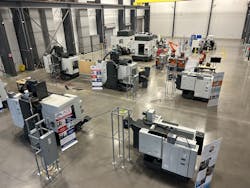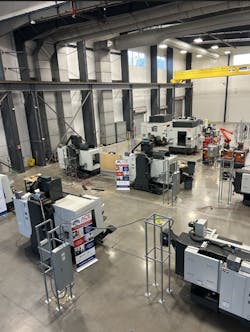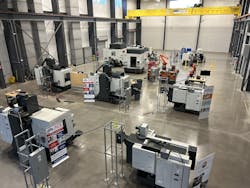“Our budget for 2023 is $25 million to distribute in scholarships, manufacturing competitions including SkillsUSA, World Skills, Project MFG, SAE, FIRST Robotics and this naming rights program,” explained Kathy Looman, director of education & Gene Haas naming grants at the Gene Haas Foundation in Oxnard, California. “The naming rights grant program is a capital grant—construction, windows, doors, flooring, paint, air and electrical, however it can also be used for program support if the building has already been retrofitted.”
The MTRC will host the Gene Haas Foundation Machining Research Academy (Figure 2).
The mission of the Gene Haas Foundation is to introduce young people to careers in manufacturing technology with an emphasis on CNC, said Looman. “Additionally, should one choose a manufacturing pathway, our vision is to make that pathway smooth by providing scholarships,” she added. “Also, we partner with what we believe are the best CNC training programs around the world to highlight them as examples to other schools, as well as to provide funds to accommodate more students.”
Because the Gene Haas Foundation is a private family foundation, the grant funds can never be used for Haas products or the services of the Haas Factory Outlet (HFO) dealer network.
“UT Engineering has been a leader in research to improve manufacturing processes and training students with a very hands-on ‘design for manufacturing’ pedagogy,” noted Looman. “But the reason for the large amount of this grant compared to many of the others we have funded is their work in developing and managing the ACE America’s cutting-edge bootcamp curriculum, in partnership with the Department of Defense (DOD) to repair our manufacturing infrastructure in the United States. We support the Project MFG competitions, which are also DOD-driven, including the SEC machining competition at UT and the ACE program as separate annual grants.”
Gene Haas Foundation Naming Rights Grant Information & Proposal Guidelines
In 2014, the Gene Haas Foundation announced a new grant program for the top CNC machinist training facilities in North America. In 2018, this initiative expanded to Europe. The program is an endorsement of the very best CNC training programs in the world with a focus on training in advanced machining processes such as five-axis machining, multi-axis turning, robot articulation and advanced metrology.
The program must be a leader in developing the manufacturing pipeline of future manufacturing by also working closely with the K-12 programs that fill the program. The instructors must be active participants in the manufacturing education community, and the program must be a leader in embracing advanced technology and demonstrating this in the training at the schools.
In exchange for naming of the building or lab, the Gene Haas Foundation grants a cash award to assist the program in this expansion.
Applicants for the grant must:
• provide a brief overview of the school’s history and accomplishments
• describe the school’s mission and focus, including how long manufacturing courses have been offered
• describe future expansion plans in all manufacturing-related programs
• describe the student population, including the percentage of students who are recent high-school graduates, displaced workers, individuals enrolled in corporate training programs, adult education and transitioning military
• explain what degrees, certifications and credit and non-credit programs are offered
• cite how many students pass through the manufacturing technology programs annually, including how many specifically in CNC machinist training
• explain what manufacturing-focused student organizations and competitions students can join.
About the Author
Mike Bacidore
Editor in Chief
Mike Bacidore is chief editor of Control Design and has been an integral part of the Endeavor Business Media editorial team since 2007. Previously, he was editorial director at Hughes Communications and a portfolio manager of the human resources and labor law areas at Wolters Kluwer. Bacidore holds a BA from the University of Illinois and an MBA from Lake Forest Graduate School of Management. He is an award-winning columnist, earning multiple regional and national awards from the American Society of Business Publication Editors. He may be reached at [email protected]

Leaders relevant to this article:



